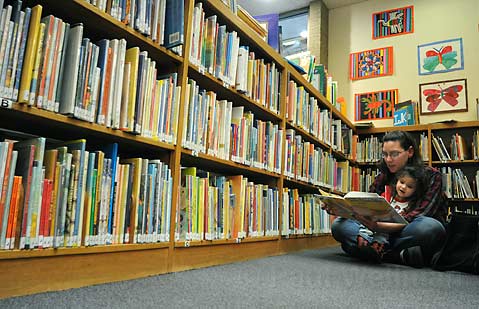Libraries Busy in Faltering Economy
Public System Affected by Budget Cuts

As economic troubles have swept the nation, many who might normally turn to cable television or rented movies for solace are finding that the public library offers a more economical escape from everyday life. Already busy, Santa Barbara’s library system has been receiving an exceptionally high volume of visitors lately, as area residents flock to the free books, DVDs, and Internet access. However, economic strife has also affected a number of public institutions as city, county, and state budgets have been cut, and public libraries are no exception. “That is the irony of it all. Whenever the economy is bad, people turn to the library for entertainment and [online] job searches, but next year is going to be difficult and we’re looking at reductions,” said Irene Macius, director of the Santa Barbara Public Library System.
The library system in south Santa Barbara County is unique in that it is run by the City of Santa Barbara but funded by individual municipalities, in contract fashion. That means that the libraries in Santa Barbara receive funding from different sources than do the smaller ones in Goleta, Carpinteria, Montecito, and Santa Ynez. While all libraries in California are partially funded by the state, Macius said that this money doesn’t amount to much in the grand scheme of things, with roughly $80,000 in state money divided between six libraries. The amount each library receives is based upon the population served by each branch. Other funding comes from the municipality in which a library is located, and the county contributes about $7 for each of the system’s approximately 231,000 users. Furthermore, all of the libraries have support groups that raise money by holding book sales and soliciting donations. “It’s very complicated because we’re dealing with so many municipalities,” Macius explained.
Despite cutbacks of staffing and hours at the Central and Eastside libraries-which are financed largely by the City of Santa Barbara’s general fund-Goleta City Manager Dan Singer said that although the City Council has not yet discussed the library budget for this year, he does not anticipate cuts for the Goleta Library. “We’ve been looking for about two years now at how to increase service levels and increase revenue, but we have no expectation of cutting the library budget,” he said. Since 1980, Goleta residents have paid a special parcel tax-first to the county and now to the relatively new city-which currently stands at about $19 per residential parcel. “[The parcel tax] has provided Goleta with a higher level of service, but the value of those dollars has eroded,” said Macius, although she noted that the tax rises with increases in the cost of living portion of the consumer price index.
Depending upon the locale, the “friends groups”-nonprofits formed to raise money for the libraries-can be a significant source of funding. Corinne Horowitz, president of Friends of the Goleta Library, said that her organization raises between $25,000 and $35,000 per year from book sales, and Macius said that the Friends of the Montecito Library enjoys generous members, with roughly $70,000 raised for the Montecito Library last year. “We provide them with funding for things they wouldn’t normally have money for,” said Horowitz, adding that because most of their money is raised by selling used books throughout the year at one or two dollars each, it is unlikely that they will see their source of income flag. “We work very hard, and have volunteers at the library every day sorting through book donations,” she said.
An added bonus to Santa Barbara’s library system are the two higher-education libraries in town. While the city’s libraries may have curtailed hours, library patrons have the option of using resources available at SBCC and UCSB. Anyone can go to these libraries and use materials onsite, but there are fees associated with borrowing. According to UCSB’s Web site, members of the public can purchase a one-year library card for $100, or for $25 if they join the $40 UCSB Affiliates. SBCC’s library cards are considerably less expensive-joining Friends of Luria Library carries a $10 annual fee and guarantees full access to the materials in SBCC’s campus library.



